Mantle clocks
A mantle clock is a luxurious piece of interior, which style and finishing are determined by the placement and spatial environment. The history of their creation is rooted in the distant XVI century. The earliest examples are dated by 1549 (Master X. Shtaynmaysel) and 1568 (the master Caspar Behain).
Nothing is known about the artist, who created the first mantle clock with beautifully decorated cases and decorated with carved and engraved ornaments. The work of Bahain is different by its original design. The watch case is made of gilded bronze and decorated with carved allegorical figures. Feature of the model is the presence of a few dials: one of them shows the time, the other - the movement of the starry circle of the zodiac, and the third - apparently, a special horoscope with all sorts of predictions. The owner of this luxury clock could only be a very wealthy man who understands a lot about jewelry and astrology. At that time the presence of a horoscope in watches was a rarity. Apparently, the clock was ordered by a man fascinated by astrology and the occult sciences. At that time it was the most enlightened people, often crowned heads. It is possible that the old mantle clock decorated rooms of a king.
|
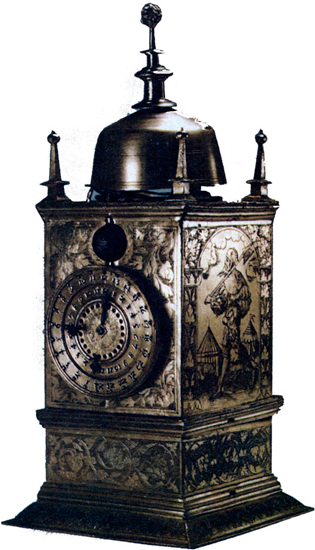
Mantel clock. Master X. Shtaynmaysel. Prague, 1549
|
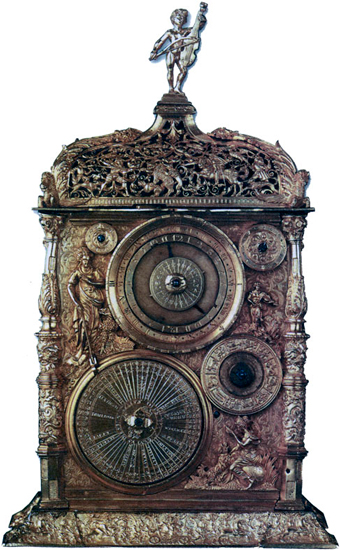
Mantel clock. Master K. Behain, 1568
|
In the XVI century, the main customers of mantel clocks were kings and nobles. Wider distribution mantle clocks received at the end of XVII century and at the beginning of the XVIII century. Then the fire was one of the most important decorative elements of the interior city of palaces of the nobility. Marble portals crowned at top by intricately decorated mantel, were central in the design of the French houses. Even special rules of mantelpiece decoration were introduced during the reign of Sun King Louis XIV. Thus, precious decorative elements appeared there: chandeliers with candles, porcelain figurines, patterned boxes and clocks. A French monarch facilitated the development of watch making: watchmakers of court were considered as a privileged caste that was under the patronage of the king. Besides watchmakers to the court were invited bronze and stone masons who created luxury mantle clocks made of gilded bronze and marble. The best masters continued to serve under the patronage of Louis XVI, who also invited jewelers, casters, engravers, gilders, engravers, sculptors, carpenters, painters on the enamel and other. Foundry hands embodied in bronze the wildest fantasies of sculptors, engravers imparted completeness to finished casting, gilders covered products with a thin layer of a noble metal, and engravers by special incisors decorated metal surface with various ornaments.
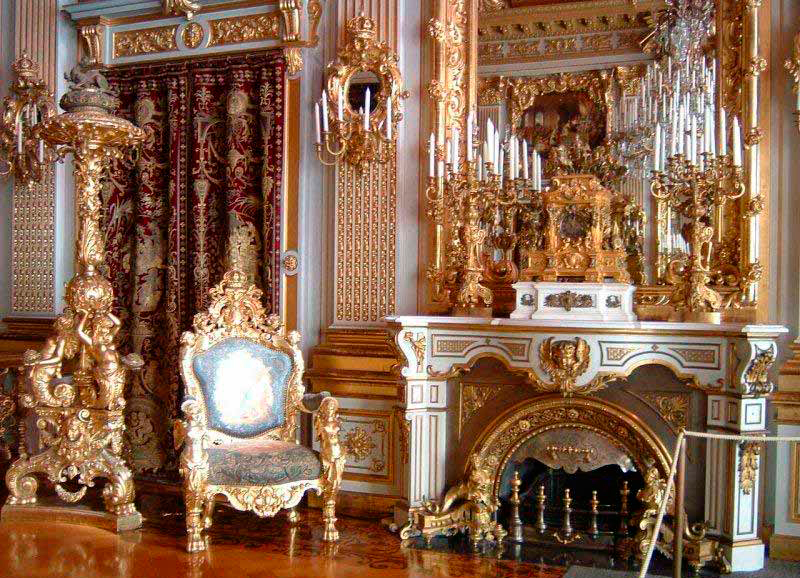
Mantel clock in the Herrenchiemsee castle-palace
Bronze sculptures usually were made in the technique of castling with wax model. Then, the finished product was gold-plated: at initial stage was used mercury (fire) gilding, from the 40s of the XIX century was widely used galvanic gilding. Adhered by the art rules of chiaroscuro, master of gilding created cases with a matte muted shine.
French masters were famous by picturesque gilt and patinated (creating the effect of dark, olive-bronze by depositing oxides on casting), and by filigree detailed castings. XVIII century, in fact, was the "golden age" in the history of French watch making. Famous masters created real masterpieces of art in which were used gilt bronze figure compositions and elements of tin and brass, silver and tortoise shell. Then mantel clocks were not carrying only a functional purpose and considered part of the decorative arts. Small round boxes of mechanism installed in voluminous, art decorated cases with sculptures. As decorative elements were used figures of satyrs and cupids. Curly plastic of mantel clock replicated biblical scenes, scenes from antique mythology, etc.
|
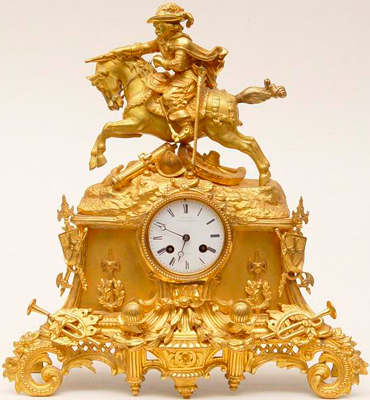
Mantel clock "Cavalier on horseback"
|
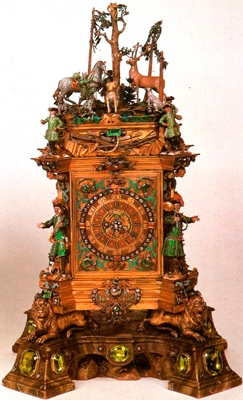
Mantle clock
|
In English mantel clocks the primary focus was to demonstrate the functionality of the mechanism. Clock cases mostly were made of wood, and bronze was used for finishing. English mantel clocks were differed from the French not only to the architecture, but also by the method of applying time division. A characteristic feature of French watches was a special method of accentuation of numbers on the dial. To more clearly emphasize the plate with divisions, each index was placed in a separate metal or porcelain dial, and then it was covered with black enamel (later masters started using a blue enamel). Form of mantel clocks and finishing depend on the change of eras and styles in art history. Thus, at different times clocks were made in different styles - Baroque, Rococo, «aux sauvages» (watch with figures of blacks, Indians, etc.), the Empire. Depending on the prevailing style, surface of cases were decorated with different ornaments.
|
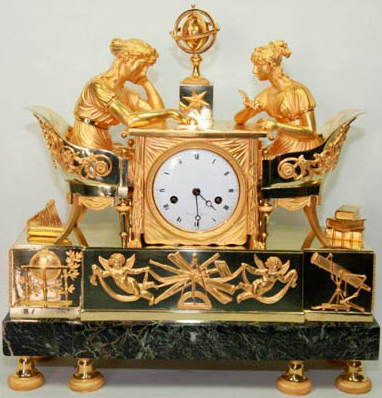
Mantle Clock Empire, 1810
|
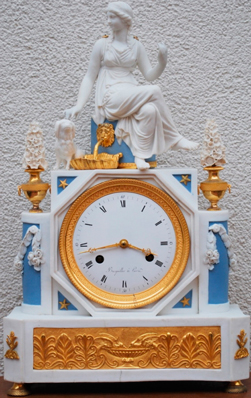
Mantle Clock, 1800
|
French mantel clocks of the first half of the XVIII century were made in the Baroque style, which was characterized by an abundance of luxury and decorative items. Typically, clocks were made of the same materials as the fireplaces themselves (mostly marble and bronze). In the second half of the XVIII century in vogue were watch-rotators, which had mobile ringed dials and one fixed hour hand (often made in the form of arrows of Cupid or snake head with hanging out tongue.)
In creation of mantel clocks were mostly used white marble and gilded bronze. At that time the authorship of works was determined by the signature: the signature of mechanic-watchmaker was applied on enamel dial and bronze. Since the XIX century on the dial was set only the name of a watchmaker or watch manufacturer, and brand label of bronze casting was placed on the case back.
In the XIX century the production of mantel clocks reached its peak: new developments in the field of engineering and bronze casting promoted the development of the watch industry.
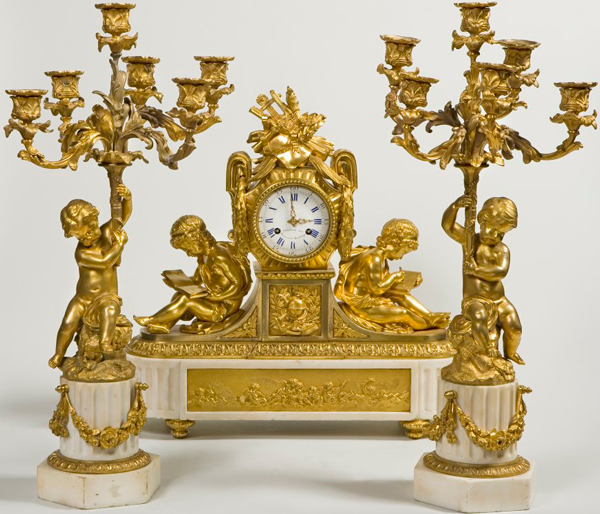
Mantel clock with figures on a marble pedestal. France first half of the XIX century
Gradually interior accessories have come into vogue (furniture, lamps, chandeliers, clocks), performed in a solemn and strict Empire style, which is characterized by antique decor items and heroic allegories of the Roman Empire. Different watches with combined cases appeared - gilt and patinated bronze was used in combination with red marble, jasper, etc. There were new models in cases, adorned with large-scale sculptures. As decorative elements were used figures reproducing biblical scenes, scenes from classical mythology, etc.
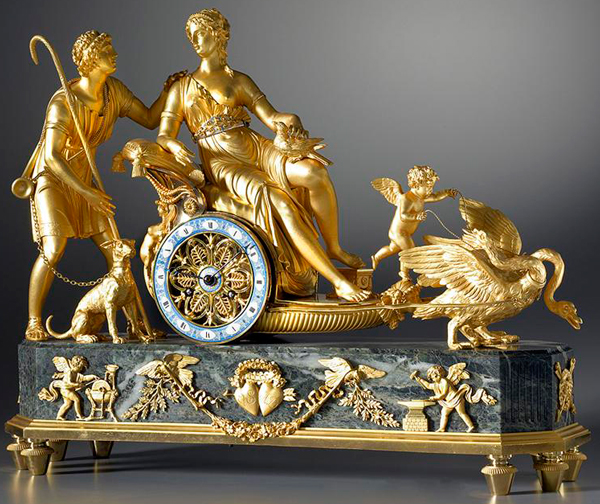
Mantle clock
In the 30’s of the XIX century the complex and ornate Empire-style forms were replaced with watch-skeletons showing the skill and ingenuity of watchmakers. In the middle of XIX century decorative art gave a way to a new style decision. In the arts and crafts of a period of eclecticism: in one case form were used elements of previous styles - Baroque, Rococo, Empire, etc. For the decoration of the case were used porcelain and glass inserts, the combination of which sometimes seemed not artistic. In the 70's in fashion were mantle clocks made of black marble (sometimes also wooden models were lacquered "under the black marble"). At the end of XIX century rotunda watches and watches portals were very fashionable (especially ancient Greek motifs).
In England at this time were in vogue wooden mantel clocks with moderately decorated cases made of oak and mahogany. Decorative elements were often made with edging of boxwood. The practice of location next to the fireplace pair ornaments has resulted of creation "de Chemin" - fireplace set, consisting of the clocks, candlesticks and vases, made in the same stylistic decision.
In the late XIX - early XX centuries form and content of mantelpiece clocks was equalized: great attention was paid not only to design of watches, but also to mechanism.
|
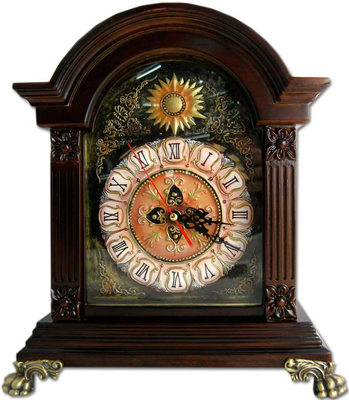
Mantle clock
|
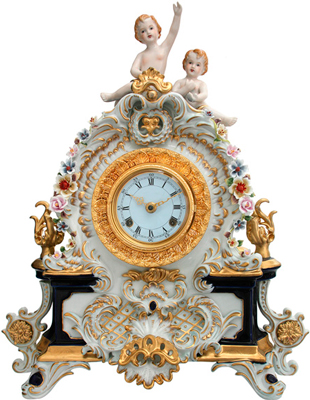
Mantle clock
|
At that time the most perfect collection of mantel clocks Cartier Mystery Clock appeared. The first model was developed in collaboration by Louis-Francois Cartier and Maurice Coue. Together, they have implemented a magical idea of Mystery Clock, based on the magic of optical illusion. The highlight of the "mystical" clocks was the "lightness" of the mechanism: the optical effect creates the illusion of "floating" dial in the air.
Within a few years the French watch house produced about 30 models of mantelpiece clocks, different from the traditional analogue by their style (neoclassical, Oriental, Art Deco), or architectural structure (screen, single-axis, portico). To buy Mystery Clock mantel clock can the wealthiest people of the world: the Maharaja of Patiala Sir Bhupindra Singh, American banker and philanthropist Joan Pierpont Morgan - Jr., and the King of England George V.
|
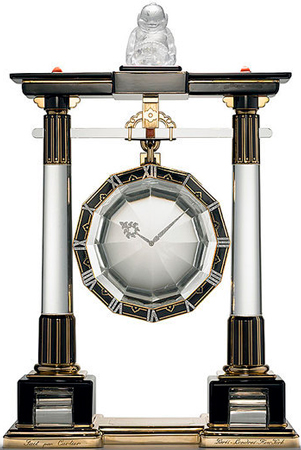
Large Portique Mystery Clock, 1923
|
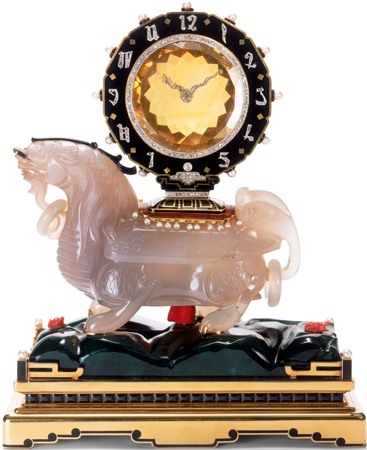
Chimera Mystery Clock, 1926
|
In 1925, the French magazine «La Gazette du Bon Ton» called the perfect creation of Cartier «a miracle of watch making." In the XIX-XX centuries mantel clocks were very popular not only in France and England, but also in many other countries, including Russia (first mantel clocks appeared in Russia in XVII-XVIII centuries, during the reign of Peter I).
Works of Carl Faberge are especially valuable. One of the most original creations of the court jeweler is a clock created to celebrate the silver wedding anniversary of Emperor Alexander III and Maria Fedorovna. The gift was ordered by 32 members of the royal family, which is evidenced by a commemorative engraving on the case back.
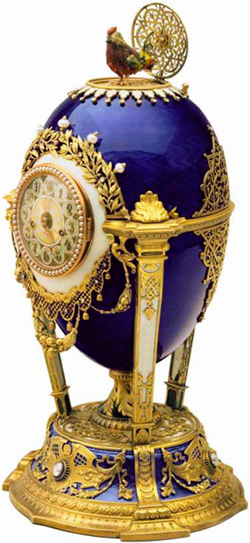
Egg "Rooster." 1900 Singing clock with winding popping cock. Faberge.
Meter mantel clock made of silver and onyx is set on a stone pedestal. In decorating the case is used precious stones, silver figure of cupids, two-headed eagle, the symbol of the Romanovs - griffin. For several years, the emperor clock has been set in the Anichkov Palace.
Finishing of clock is in perfectly harmony with the colors of the room and decor of fireplace. First mantle clock was put on display in the palace of Baron von Derviz in St. Petersburg in 1902. After the October Revolution, it appeared abroad, and now it is in the private collection of an unknown foreign owner.
***
In the middle of the XX century mantel clocks lost their former leadership: in part this was due to the world wars and the subsequent historical cataclysms. Fashion of XXI century has gradually returned to the house fireplace sets, though modern analogs are not produced according to ancient techniques. A technique of gray stone is used the most frequently: crushed marble crumbs and binder composition is poured into the prepared form, freeze, after then prepared casting is subjected to special heat treatment. Stones products are durable, abrasion resistance, chemical resistance, temperature resistance and fire resistance.
On operational indicators can compete with bronze items. In its quality wooden, plaster and ceramic cases significantly give way to inferior stone items. Thanks to special staining techniques, the surface of stone items mimics the bronze. The technique of gilding is often used. The use of stone casting technique allows reduce the price of mantle clocks in 5-6 times.
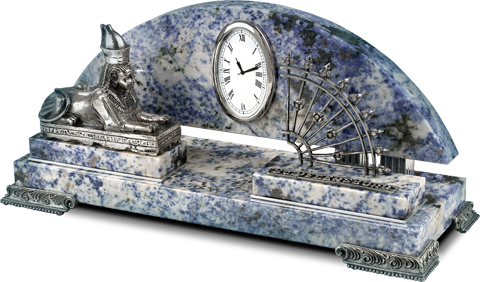
Mantel clock "Petersburg"
In modern analogs, except marble crumbs, is used as an artificial wood (often used a combination of stone sculptures, painted a stained wood, with wooden cases). In the manufacture of modern mantelpiece clocks has found its widely use a technique of stained glass. A stained-glass window is made by classical Venetian technology of dyed in the mass of glass and metal. The idea to use in the design of the clock case a mosaic of stained glass windows makes it possible to bring in home décor a piece of antique architectural decoration.
Collectible value of mantel clocks
Today, as before, mantel clocks are an important element in interior design. They convey a piece of antiquity, which the most need in the world of high technology. Particularly impressive antique mantel clocks look in country and retro style. Modern manufacturers of interior clocks often turn to old patterns. In their collections you can find some incredible examples that mimic the shape and finish of clock represented in the Louvre, the castles of the Loire, Versailles, Venetian palazzo, etc. In making of the latter, as a rule, are used the same materials as in the antique models. Such pieces are worth big money.
But you can buy a mantel clock, and for less money: in the production of less expensive items are used stone crumbs and an artificial wood, which, thanks to new treatment technologies are not visually different from traditional materials. Often, in complete with mantle clocks are produced candlesticks and vases, made in the same style decisions. This ensemble will give any room a luxurious look and reminds of times gone in history.
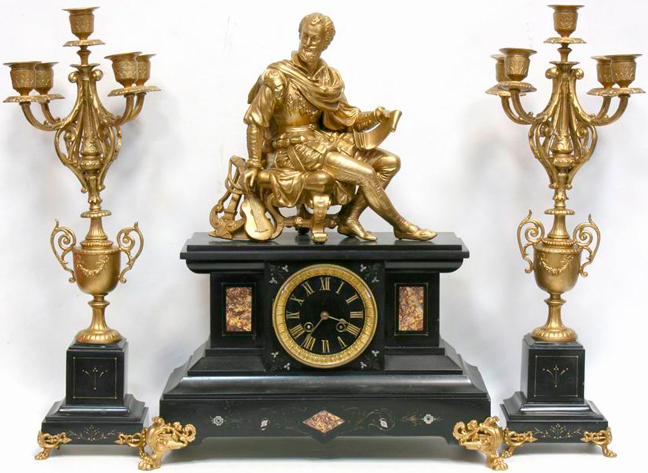
Mantel clock "Musician" with twin chandeliers
From the point of view of collecting modern analogs are no values. Collectible are considered antique mantel clocks, whose creation dates back to XVIII, XIX and early XX centuries. Today they can be seen only in museums, antique shops and private collections. Collectible mantle clocks are the forgotten and out-of frequent use decorative - applied art items. Today, these rare masterpieces of horology are very popular in international auctions and exhibitions. Particular interest in selling of mantel clocks is shown by the auction houses Sotheby's and Christie's.
SinCera
|


